Habitat Types and Species
Habitats of NH and the animals that live there
The New Hampshire landscape is rich with habitats for fish and wildlife -- from granite peaks, forests, and wetlands to grasslands, coastal islands, and nearly a thousand lakes and ponds. Twenty-seven habitats are identified in NH’s Wildlife Action Plan -- some of them common and some extremely rare. Most are mapped in GIS so they can be used to plan and prioritize habitat protection, restoration, or research.
New Hampshire is home to more than 500 different wildlife species. The Wildlife Action Plan identifies 169 of these as a ‘Species of Greatest Conservation Need.’ In the charts below you can find information about New Hampshire’s habitat types, the wildlife species that can be found there, and helpful links to learn more. Please note that these are just brief summaries; complete descriptions of habitats, their components, wildlife species and the justification for their conservation, data sources and citations can be found in Appendices A and B of the Wildlife Action Plan.
See Also:
Appalachian Oak-Pine Forest
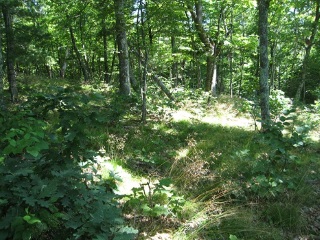 Appalachian oak-pine forests are found mostly below 900 feet elevation in southern New Hampshire and along the Connecticut River in western New Hampshire. The nutrient-poor, dry, sandy soils and warm, dry, climate influences the typical vegetation including oak, hickory, mountain laurel, and sugar maple. Many wildlife species use these forests for part or all of their life cycle including whip-poor-wills, black bears, northern myotis, and state endangered eastern hognose snakes. Traditionally, Appalachian oak-pine forests are influenced by frequent fires, which change the age structure of the forest. The diverse age and structure of the forest help to promote wildlife diversity. Intense development pressure particularly in the southeast corner of New Hampshire has dramatically reduced naturally occurring fires and increased fragmentation of this forest type. Incorporating habitat conservation into local land use planning, protecting unfragmented blocks, and adopting sustainable forestry are a few examples of conservation strategies for Appalachian oak-pine forests.
Appalachian oak-pine forests are found mostly below 900 feet elevation in southern New Hampshire and along the Connecticut River in western New Hampshire. The nutrient-poor, dry, sandy soils and warm, dry, climate influences the typical vegetation including oak, hickory, mountain laurel, and sugar maple. Many wildlife species use these forests for part or all of their life cycle including whip-poor-wills, black bears, northern myotis, and state endangered eastern hognose snakes. Traditionally, Appalachian oak-pine forests are influenced by frequent fires, which change the age structure of the forest. The diverse age and structure of the forest help to promote wildlife diversity. Intense development pressure particularly in the southeast corner of New Hampshire has dramatically reduced naturally occurring fires and increased fragmentation of this forest type. Incorporating habitat conservation into local land use planning, protecting unfragmented blocks, and adopting sustainable forestry are a few examples of conservation strategies for Appalachian oak-pine forests.
Species:
- American Woodcock
- Bald Eagle
- Big Brown Bat
- Black-billed Cuckoo
- Blue-Spotted Salamander Complex
- Cerulean Warbler
- Chimney Swift
- Common Nighthawk
- Coppery Emerald
- Eastern Box Turtle
- Eastern Hog-nosed Snake
- Eastern Red Bat
- Eastern Small-footed Bat
- Eastern Towhee
- Eastern Whip-poor-will
- Fowler's Toad
- Golden Eagle
- Hoary Bat
- Jefferson Salamander Complex
- Little Brown Bat
- Marbled Salamander
- Moose
- Northern Black Racer
- Northern Goshawk
- Northern Long-eared Bat
- Purple Finch
- Rapids Clubtail
- Ringed Boghaunter
- Ruffed Grouse
- Scarlet Tanager
- Silver-Haired Bat
- Skillet Clubtail
- Timber Rattlesnake
- Tricolored Bat
- Veery
- Wood Thrush
Hemlock Hardwood Pine Forest
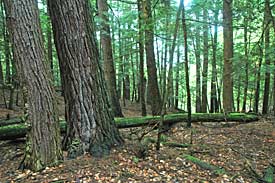 Hemlock-hardwood-pine forests are comprised of mostly hemlock, white pine, beech, and oak trees. Since this is a transitional forest, it can occur at different elevations and over different types of soil and topography, so the composition of vegetation can be variable. This forest type is the most common in New Hampshire and covers nearly 50% of the state and provides habitat for numerous wildlife species such as the cerulaean warbler, eastern pipistrelle, and bobcat. Many of the species that use this habitat type require large blocks of unfragmented forest such as the northern goshawk and black bear. Since this forest type is so common, it is sometimes overlooked in conservation efforts. Development and fragmentation is a huge threat to the continued existence of hemlock-hardwood-pine forest. Some conservation strategies for hemlock-hardwood-pine forests are incorporating habitat conservation into local land use planning, protecting unfragmented blocks of land, and educating landowners.
Hemlock-hardwood-pine forests are comprised of mostly hemlock, white pine, beech, and oak trees. Since this is a transitional forest, it can occur at different elevations and over different types of soil and topography, so the composition of vegetation can be variable. This forest type is the most common in New Hampshire and covers nearly 50% of the state and provides habitat for numerous wildlife species such as the cerulaean warbler, eastern pipistrelle, and bobcat. Many of the species that use this habitat type require large blocks of unfragmented forest such as the northern goshawk and black bear. Since this forest type is so common, it is sometimes overlooked in conservation efforts. Development and fragmentation is a huge threat to the continued existence of hemlock-hardwood-pine forest. Some conservation strategies for hemlock-hardwood-pine forests are incorporating habitat conservation into local land use planning, protecting unfragmented blocks of land, and educating landowners.
Species:
- American Woodcock
- Bald Eagle
- Big Brown Bat
- Black-billed Cuckoo
- Blue-Spotted Salamander Complex
- Canada Warbler
- Chimney Swift
- Common Nighthawk
- Eastern Box Turtle
- Eastern Hog-nosed Snake
- Eastern Red Bat
- Eastern Small-footed Bat
- Eastern Whip-poor-will
- Golden Eagle
- Hoary Bat
- Jefferson Salamander Complex
- Little Brown Bat
- Moose
- Northern Black Racer
- Northern Goshawk
- Northern Long-eared Bat
- Purple Finch
- Rapids Clubtail
- Ringed Boghaunter
- Ruffed Grouse
- Scarlet Tanager
- Silver-Haired Bat
- Skillet Clubtail
- Timber Rattlesnake
- Tricolored Bat
- Veery
- Wood Thrush
High Elevation Spruce-Fir Forest
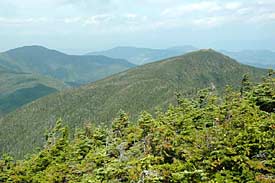 High-elevation spruce-fir forests can be found between 2,500 and 3,500 feet in elevation on upper mountain slopes and ridge tops. Harsh climatic extremes and highly erosive soils play a significant role in determining the vegetative species found in this habitat type, which typically includes red spruce, balsam fir, and paper and yellow birches. High-elevation spruce-fir forest has a very limited distribution in New Hampshire, covering approximately 4% of the state's land area, and provides some of the last areas relatively free of human disturbance. The wildlife species that are found in this habitat include the federally threatened and state endangered Canada lynx and the state threatened American marten. Spruce grouse and Bicknell's thrush also use this habitat. Not only do the trees at this elevation have to cope with the harsh climate, but they must also deal with the stress effects of acid deposition. The high elevation also presents another potential threat: energy and communication infrastructure. High elevation spruce-fir soils are also shallow, so forestry operations can easily damage the fragile soils. Conservation strategies for high-elevation spruce-fir forests include habitat protection and examining potential wildlife habitat degradation from wind farm construction.
High-elevation spruce-fir forests can be found between 2,500 and 3,500 feet in elevation on upper mountain slopes and ridge tops. Harsh climatic extremes and highly erosive soils play a significant role in determining the vegetative species found in this habitat type, which typically includes red spruce, balsam fir, and paper and yellow birches. High-elevation spruce-fir forest has a very limited distribution in New Hampshire, covering approximately 4% of the state's land area, and provides some of the last areas relatively free of human disturbance. The wildlife species that are found in this habitat include the federally threatened and state endangered Canada lynx and the state threatened American marten. Spruce grouse and Bicknell's thrush also use this habitat. Not only do the trees at this elevation have to cope with the harsh climate, but they must also deal with the stress effects of acid deposition. The high elevation also presents another potential threat: energy and communication infrastructure. High elevation spruce-fir soils are also shallow, so forestry operations can easily damage the fragile soils. Conservation strategies for high-elevation spruce-fir forests include habitat protection and examining potential wildlife habitat degradation from wind farm construction.
Species:
American Marten
American Three-toed Woodpecker
Bald Eagle
Bicknell's Thrush
Canada Lynx
Golden Eagle
Eastern Wolf
Long-tailed Shrew
Moose
Northern Bog Lemming
Purple Finch
Ringed Emerald
Rock Vole
Sedge Darner
Spruce Grouse
Lowland Spruce
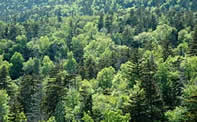 Lowland spruce-fir forests occur between 1,000 and 2,500 feet in elevation and are comprised of a mosaic of lowland spruce-fir forest and red spruce swamp communities. Typical vegetation includes red spruce, balsam fir, hobblebush, and bunchberry. Although lowland spruce-fir covers approximately 10% of the state, it provides habitat for over 100 vertebrate species from spruce grouse to black bear to hoary bats. Lowland spruce-fir forests also contain very important deer wintering areas. During heavy snow years, these forests provide an area for white-tailed deer to yard up where the conifer trees provide food and shelter from the heavy snow. The federally threatened and state endangered Canada lynx uses this habitat as well as two state threatened wildlife species: American three-toed woodpecker and American marten. In some areas, forest harvesting in this habitat has resulted in trees that are less than 2 inches in diameter. In other areas, cutting has converted the landscape to northern hardwood conifer forest. Some conservation strategies for lowland spruce-fir forests are to protect unfragmented blocks of land and to maintain late successional habitat.
Lowland spruce-fir forests occur between 1,000 and 2,500 feet in elevation and are comprised of a mosaic of lowland spruce-fir forest and red spruce swamp communities. Typical vegetation includes red spruce, balsam fir, hobblebush, and bunchberry. Although lowland spruce-fir covers approximately 10% of the state, it provides habitat for over 100 vertebrate species from spruce grouse to black bear to hoary bats. Lowland spruce-fir forests also contain very important deer wintering areas. During heavy snow years, these forests provide an area for white-tailed deer to yard up where the conifer trees provide food and shelter from the heavy snow. The federally threatened and state endangered Canada lynx uses this habitat as well as two state threatened wildlife species: American three-toed woodpecker and American marten. In some areas, forest harvesting in this habitat has resulted in trees that are less than 2 inches in diameter. In other areas, cutting has converted the landscape to northern hardwood conifer forest. Some conservation strategies for lowland spruce-fir forests are to protect unfragmented blocks of land and to maintain late successional habitat.
Species:
American Three-toed Woodpecker
Bald Eagle
Big Brown Bat
Canada Lynx
Canada Warbler
Cape May Warbler
Chimney Swift
Eastern Red Bat
Golden Eagle
Hoary Bat
Little Brown Bat
Moose
Northern Bog Lemming
Northern Goshawk
Northern Long-eared Bat
Northern Hardwood-Conifer Forest
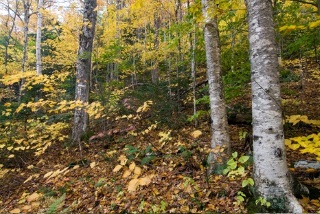 This habitat type is typically found between 1,400 and 2,500 feet in elevation and is usually made up of hardwood trees such as American beech, sugar maple, yellow birch, and conifer trees such as eastern hemlock, white pine, and balsam fir. Most of northern hardwood conifer habitat occurs in central and northern New Hampshire. This transitional zone provides habitat for many wildlife species including state threatened species: bald eagle, who nest and roost near lakes and rivers, and peregrine falcons who nest on cliffs but hunt over the forest. Other typical species in this habitat include ruffed grouse, wood thrush, and northern long-eared bat. Development pressure is heavy within some parts of this habitat type. Forest harvesting is common in this habitat and if done sustainably produces the diversity of age classes and species which is beneficial to wildlife. Forestry also has increased this type of habitat by converting spruce-fir habitats to the more economically valuable northern hardwoods. Some conservation strategies for northern hardwood conifer forests are incorporating the habitat into local conservation planning, protecting unfragmented blocks of land, and advocating for the adoption of sustainable forestry.
This habitat type is typically found between 1,400 and 2,500 feet in elevation and is usually made up of hardwood trees such as American beech, sugar maple, yellow birch, and conifer trees such as eastern hemlock, white pine, and balsam fir. Most of northern hardwood conifer habitat occurs in central and northern New Hampshire. This transitional zone provides habitat for many wildlife species including state threatened species: bald eagle, who nest and roost near lakes and rivers, and peregrine falcons who nest on cliffs but hunt over the forest. Other typical species in this habitat include ruffed grouse, wood thrush, and northern long-eared bat. Development pressure is heavy within some parts of this habitat type. Forest harvesting is common in this habitat and if done sustainably produces the diversity of age classes and species which is beneficial to wildlife. Forestry also has increased this type of habitat by converting spruce-fir habitats to the more economically valuable northern hardwoods. Some conservation strategies for northern hardwood conifer forests are incorporating the habitat into local conservation planning, protecting unfragmented blocks of land, and advocating for the adoption of sustainable forestry.
Species:
- American Marten
- Bald Eagle
- Big Brown Bat
- Blue-Spotted Salamander Complex
- Canada Warbler
- Chimney Swift
- Eastern Red Bat
- Eastern Small-footed Bat
- Eastern Whip-poor-will
- Golden Eagle
- Eastern Wolf
- Hoary Bat
- Jefferson Salamander Complex
- Little Brown Bat
- Long-tailed Shrew
- Moose
- Northern Bog Lemming
- Northern Goshawk
- Northern Long-eared Bat
- Olive-Sided Flycatcher
- Purple Finch
- Rapids Clubtail
- Ringed Emerald
- Rock Vole
- Ruffed Grouse
- Scarlet Tanager
- Sedge Darner
- Silver-Haired Bat
- Southern Bog Lemming
- Tricolored Bat
- Veery
- Wood Thrush
Alpine
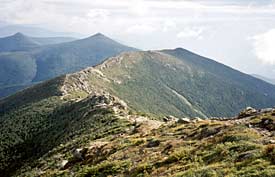 Alpine habitat occurs above treeline at around 4,900 feet elevation and is characterized by high winds, precipitation, cloud cover and fog. This results in low annual temperatures and a short growing season. New Hampshire is home to many high peaks that have alpine habitat including the tallest in the Northeast: Mount Washington. Alpine areas support unique plant communities such as Bigelow's sedge meadows which provide habitat for site-specific species like the state endangered White Mountain fritillary and the state threatened White Mountain arctic butterfly. Many birds can also be found in these habitats, but one in particular breeds in alpine habitat, the American pipit. It is uncertain exactly what weather conditions will come with climate change, but it is certain that these unique communities will not have enough time to respond to these potential changes. Another less talked about threat to these habitats are human impacts on recreational hiking trails. These wind blown environments are holding on in cracks and crevices and any loss of soil or vegetation can set the clock back hundreds of years. Hikers are urged to stay on established trails. Some conservation strategies for alpine habitat are restoring rare plant communities and educating alpine recreation users about their potential impacts.
Alpine habitat occurs above treeline at around 4,900 feet elevation and is characterized by high winds, precipitation, cloud cover and fog. This results in low annual temperatures and a short growing season. New Hampshire is home to many high peaks that have alpine habitat including the tallest in the Northeast: Mount Washington. Alpine areas support unique plant communities such as Bigelow's sedge meadows which provide habitat for site-specific species like the state endangered White Mountain fritillary and the state threatened White Mountain arctic butterfly. Many birds can also be found in these habitats, but one in particular breeds in alpine habitat, the American pipit. It is uncertain exactly what weather conditions will come with climate change, but it is certain that these unique communities will not have enough time to respond to these potential changes. Another less talked about threat to these habitats are human impacts on recreational hiking trails. These wind blown environments are holding on in cracks and crevices and any loss of soil or vegetation can set the clock back hundreds of years. Hikers are urged to stay on established trails. Some conservation strategies for alpine habitat are restoring rare plant communities and educating alpine recreation users about their potential impacts.
Species:
- American Pipit
- Ringed Emerald
- White Mountain Arctic
- White Mountain Fritillary
Caves and Mines
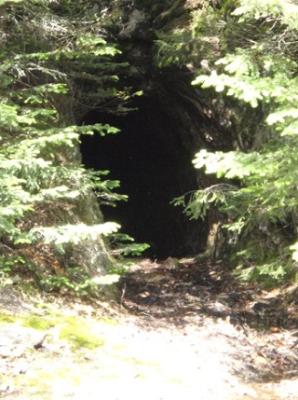 Caves and mines are distinguished from all other New Hampshire habitats by being located below ground. Cave and mine habitat does not represent an ecosystem, but rather an abiotic (non-living) habitat type. Most of our caves are abandoned mines; these historical locations of New Hampshire's prospecting era now provide an integral part of wildlife habitat in the state. Caves and mines are extremely important for six of New Hampshire's nine bat species, such as the state endangered small footed bat. They use caves and mines as a place to overwinter. Historic mining data suggest that there could be additional sites that have not yet been identified as bat hibernacula. The most challenging issues facing cave and mine habitat are recreational activities such as spelunking and geocaching, which significantly disturb the bats, reducing their energy reserves during hibernation. Another more recent threat is White Nose Syndrome (WNS) that has recently been affecting bats in other northeastern states. Learn more about WNS. Two conservation strategies for caves and mines is habitat protection including gating off some critical bat hibernacula and educating recreational users of their potential impacts to hibernating bats.
Caves and mines are distinguished from all other New Hampshire habitats by being located below ground. Cave and mine habitat does not represent an ecosystem, but rather an abiotic (non-living) habitat type. Most of our caves are abandoned mines; these historical locations of New Hampshire's prospecting era now provide an integral part of wildlife habitat in the state. Caves and mines are extremely important for six of New Hampshire's nine bat species, such as the state endangered small footed bat. They use caves and mines as a place to overwinter. Historic mining data suggest that there could be additional sites that have not yet been identified as bat hibernacula. The most challenging issues facing cave and mine habitat are recreational activities such as spelunking and geocaching, which significantly disturb the bats, reducing their energy reserves during hibernation. Another more recent threat is White Nose Syndrome (WNS) that has recently been affecting bats in other northeastern states. Learn more about WNS. Two conservation strategies for caves and mines is habitat protection including gating off some critical bat hibernacula and educating recreational users of their potential impacts to hibernating bats.
Species:
- Big Brown Bat
- Eastern Small-footed Bat
- Little Brown Bat
- Northern Long-eared Bat
- Tricolored Bat
Rocky Ridge, Cliff, and Talus
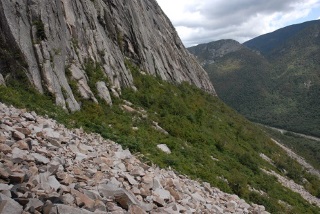 Rocky ridges and talus slopes are two related but distinct habitats. Talus slopes, comprised of loose or stable boulders and rocks, range from open, lichen covered talus "barrens" to closed-canopy forested talus communities. Rocky ridges generally occur on outcrops and bedrock ridges and summits below the alpine zone. Talus slopes and rocky ridges provide crucial habitat for several rare wildlife species in New Hampshire, including bobcat, state endangered timber rattlesnake and eastern small-footed bats, and state threatened peregrine falcon. Due to the inaccessible nature of talus slopes, human impacts exist primarily on the rocky ridge portion of this habitat, though some trails and other impacts are found on talus. Some conservation strategies for rocky ridges and talus slopes are to limit trails through high risk areas and monitoring indicator species for climate change.
Rocky ridges and talus slopes are two related but distinct habitats. Talus slopes, comprised of loose or stable boulders and rocks, range from open, lichen covered talus "barrens" to closed-canopy forested talus communities. Rocky ridges generally occur on outcrops and bedrock ridges and summits below the alpine zone. Talus slopes and rocky ridges provide crucial habitat for several rare wildlife species in New Hampshire, including bobcat, state endangered timber rattlesnake and eastern small-footed bats, and state threatened peregrine falcon. Due to the inaccessible nature of talus slopes, human impacts exist primarily on the rocky ridge portion of this habitat, though some trails and other impacts are found on talus. Some conservation strategies for rocky ridges and talus slopes are to limit trails through high risk areas and monitoring indicator species for climate change.
Cliffs are steep, rocky outcrops greater than 65° in slope and 3 meters in height. They can be low in elevation within a forest or higher in elevation and completely exposed such as the historic location of The Old Man of the Mountain. Cliffs have sparse vegetation that is typically restricted to cracks and crevices where soil accumulates. Depending on the type of rock that make up the cliff, different types of vegetation will grow there such as sheep laurel on acidic cliffs and bulblet bladder fern on calcareous cliffs. Cliffs are used by several wildlife species including the state threatened peregrine falcon, state endangered timber rattlesnake, bobcat, common raven, and long-tailed shrew. Although often viewed as isolated or inaccessible to people, the popularity of cliffs and cliff tops as recreational destinations for hikers and rock climbers is rapidly increasing. Another threat to the tops of these exposed habitats is energy and communication infrastructure such as cell towers and wind turbines. Some conservation strategies for cliff habitat are educating recreational users, habitat protection, and advising wind energy developers of potentially negative impacts through regulation and policy.
Species:
- Common Nighthawk
- Eastern Small-footed Bat
- Eastern Towhee
- Golden Eagle
- Northern Black Racer
- Peregrine Falcon
- Smooth Greensnake
- Timber Rattlesnake
Developed Habitats
Residential and commercial development in New Hampshire ranges from maintained gardens and manicured lawns to multi-story buildings in city centers. Some wildlife species have learned to use these areas for things like nesting or finding food sources. For example, peregrine falcons, which typically create nests on vertical cliffs to raise their young, have begun nesting in urban settings in the southeastern portion of the state. Tall buildings and similar man‐made structures possess physical characteristics similar to cliffs. Another bird, the chimney swift, was once known to nest in large hallow trees in the forest, but as this resource has declined, the species now almost exclusively nests in the chimneys of buildings. Many bumble bee species frequent crop fields, orchards, gardens and other locations with flowering plants maintained by humans in developed areas. Although development can cause problems for wildlife, some species have figured out how to adapt to certain conditions.
Species:
- American Bumble Bee
- American Kestrel
- Chimney Swift
- Cliff Swallow
- Common Nighthawk
- Monarch
- Peregrine Falcon
- Purple Martin
- Rusty-patched Bumble Bee
- Yellow Bumble Bee
- Yellowbanded Bumble Bee
Grasslands
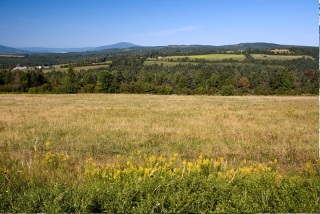 Grasslands are comprised of grasses, sedges, and wildflowers with little to no shrubs and trees. The most common grassland habitats are airports, capped landfills, wet meadows, and agricultural fields such as hayfields, pastures and fallow fields. Pre-colonial grasslands in New Hampshire were probably only maintained by beaver and fires started by lightening and Native Americans. The numerous agricultural lands maintained by early European settlers provided ideal habitat for some wildlife species that need grassland habitat. As these agricultural lands were abandoned, these populations began to decline and are now on the state endangered list such as the eastern hognose snake, northern harrier, upland sandpiper and on the state threatened list such as the grasshopper sparrow. Other species also benefit from these open grass fields such as wood turtles and numerous species of butterflies. Development and natural forest succession have reduced grassland habitat in the state. Grasslands require maintenance and must be mowed to prevent them from becoming shrublands or forests. Only 8% of NH grasslands are currently under conservation easements. Reclaiming and maintaining grasslands are two important conservation strategies for grassland habitats. Many grassland and potential grassland habitat are on private land and landowners can help restore and conserve them.
Grasslands are comprised of grasses, sedges, and wildflowers with little to no shrubs and trees. The most common grassland habitats are airports, capped landfills, wet meadows, and agricultural fields such as hayfields, pastures and fallow fields. Pre-colonial grasslands in New Hampshire were probably only maintained by beaver and fires started by lightening and Native Americans. The numerous agricultural lands maintained by early European settlers provided ideal habitat for some wildlife species that need grassland habitat. As these agricultural lands were abandoned, these populations began to decline and are now on the state endangered list such as the eastern hognose snake, northern harrier, upland sandpiper and on the state threatened list such as the grasshopper sparrow. Other species also benefit from these open grass fields such as wood turtles and numerous species of butterflies. Development and natural forest succession have reduced grassland habitat in the state. Grasslands require maintenance and must be mowed to prevent them from becoming shrublands or forests. Only 8% of NH grasslands are currently under conservation easements. Reclaiming and maintaining grasslands are two important conservation strategies for grassland habitats. Many grassland and potential grassland habitat are on private land and landowners can help restore and conserve them.
Species:
- American Bumble Bee
- American Kestrel
- American Pipit
- Bank Swallow
- Bobolink
- Cliff Swallow
- Eastern Box Turtle
- Eastern Meadowlark
- Grasshopper Sparrow
- Horned Lark
- Monarch
- Northern Black Racer
- Northern Harrier
- Northern Leopard Frog
- Purple Martin
- Ruffed Grouse
- Rusty-patched Bumble Bee
- Smooth Greensnake
- Upland Sandpiper
- Vesper Sparrow
- Wood Turtle
- Yellow Bumble Bee
- Yellowbanded Bumble Bee
Pine Barrens
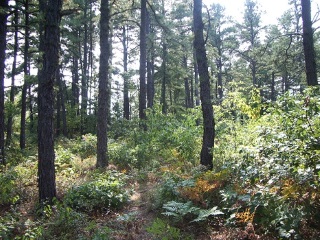 Pine barrens are among the most imperiled natural communities in the world and contribute significantly to the biological diversity of the northeast. They are dominated by pitch pine and scrub oak interspersed with pockets of grassy openings. The sandy, nutrient poor soils are typically situated along river banks and bluffs. Pine barrens plants are in constant flux, maintained by frequent disturbances such as lightning-caused wildfires, which occur naturally and regularly. These communities support a suite of regionally and globally rare species including the federally and state endangered Karner blue butterfly, and other state endangered species such as the frosted elfin butterfly, persius duskywing and common nighthawk. Other more common species can be found in pine barrens including white-tailed deer, turkey, and eastern towhee. Development, fragmentation, and altered natural disturbance regime threaten this habitat. Without disturbance, pine barrens will natural succeed to a more diverse forest type, therefore, habitat management and restoration, particularly using prescribed fire, are two of the conservation strategies for Pine Barrens.
Pine barrens are among the most imperiled natural communities in the world and contribute significantly to the biological diversity of the northeast. They are dominated by pitch pine and scrub oak interspersed with pockets of grassy openings. The sandy, nutrient poor soils are typically situated along river banks and bluffs. Pine barrens plants are in constant flux, maintained by frequent disturbances such as lightning-caused wildfires, which occur naturally and regularly. These communities support a suite of regionally and globally rare species including the federally and state endangered Karner blue butterfly, and other state endangered species such as the frosted elfin butterfly, persius duskywing and common nighthawk. Other more common species can be found in pine barrens including white-tailed deer, turkey, and eastern towhee. Development, fragmentation, and altered natural disturbance regime threaten this habitat. Without disturbance, pine barrens will natural succeed to a more diverse forest type, therefore, habitat management and restoration, particularly using prescribed fire, are two of the conservation strategies for Pine Barrens.
Species:
- Barrens Itame
- Barrens xylotype
- Black-billed Cuckoo
- Blue-winged Warbler
- Broad-lined Catopyrrha
- Brown Thrasher
- Common Nighthawk
- Cora moth
- Eastern Hog-nosed Snake
- Eastern Towhee
- Eastern Whip-poor-will
- Edward’s Hairstreak
- Field Sparrow
- Fowler's Toad
- Frosted Elfin
- Graceful Clearwing
- Karner Blue Butterfly
- Little Brown Bat
- New Jersey tea Spanworm
- Noctuid Moth
- Persius Duskywing Skipper
- Phyllira tiger moth
- Pine pinion moth
- Pinion Moth
- Prairie Warbler
- Sleepy duskywing
- Twilight Moth
- Vesper Sparrow
Shrublands
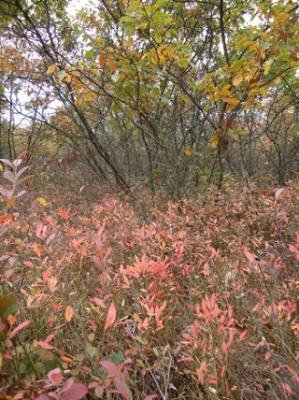 Shrubland habitats are shrub-dominated areas with scattered forbs and grasses. These habitats are typically the result of some disturbance and include dry shrublands, utility rights-of-way, old agriculture fields, and reverting gravel pits. Shrublands and other woody early-successional habitats are declining in New Hampshire and throughout the Northeast as are the associated wildlife species. Patch size is a key component of shrublands as wildlife habitats. For example, Golden-winged warblers occupy patches that are at least 10 hectares, whereas state endangered New England cottontails occupy patches in southeastern New Hampshire ranging from 0.2 to 15 hectares. Vegetation structure is also very important to shrubland habitat as some species require thick understory such as the New England cottontail and other species require dense canopy cover in addition to the shrub cover like the American woodcock. Some of the other species that can be found in shrublands include ruffed grouse, smooth green snake, wood turtle and the state threatened black racer. If left alone, many shrublands will naturally succeed into forests and therefore, natural disturbances or specific management practices should be allowed to occur to sustain this habitat. Additionally, habitat fragmentation and habitat loss due to development threatens shrubland habitats. Some conservation strategies for shrublands include habitat restoration and management.
Shrubland habitats are shrub-dominated areas with scattered forbs and grasses. These habitats are typically the result of some disturbance and include dry shrublands, utility rights-of-way, old agriculture fields, and reverting gravel pits. Shrublands and other woody early-successional habitats are declining in New Hampshire and throughout the Northeast as are the associated wildlife species. Patch size is a key component of shrublands as wildlife habitats. For example, Golden-winged warblers occupy patches that are at least 10 hectares, whereas state endangered New England cottontails occupy patches in southeastern New Hampshire ranging from 0.2 to 15 hectares. Vegetation structure is also very important to shrubland habitat as some species require thick understory such as the New England cottontail and other species require dense canopy cover in addition to the shrub cover like the American woodcock. Some of the other species that can be found in shrublands include ruffed grouse, smooth green snake, wood turtle and the state threatened black racer. If left alone, many shrublands will naturally succeed into forests and therefore, natural disturbances or specific management practices should be allowed to occur to sustain this habitat. Additionally, habitat fragmentation and habitat loss due to development threatens shrubland habitats. Some conservation strategies for shrublands include habitat restoration and management.
Species:
- American Bumble Bee
- American Kestrel
- American Woodcock
- Black-billed Cuckoo
- Blue-winged Warbler
- Brown Thrasher
- Eastern Box Turtle
- Eastern Hog-nosed Snake
- Eastern Towhee
- Eastern Whip-poor-will
- Field Sparrow
- Fowler's Toad
- Golden-winged Warbler
- Moose
- New England Cottontail
- Northern Black Racer
- Northern Harrier
- Northern Leopard Frog
- Prairie Warbler
- Ruffed Grouse
- Smooth Greensnake
- Timber Rattlesnake
- Wood Turtle
- Yellowbanded Bumble Bee
Floodplain Habitats
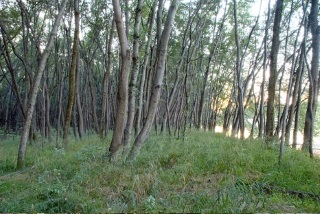 Floodplain habitats occur in valleys adjacent to river channels and are prone to periodic flooding. Also referred to as riparian forests, they support diverse natural communities, protect and enhance water quality by filtering and sequestering pollution, and control erosion and sediment. Many wildlife species use these forests at some point in their life cycle. It would not be uncommon to find red-shouldered hawks, veery, or chestnut-sided warblers breeding in floodplain forests. Evidence of beaver, mink, or otter can usually be found along the water’s edge. Other wetland types, like shrub swamps and vernal pools, can be found within floodplain forests, and these areas are particularly important for Jefferson salamanders, northern leopard frog, wood turtles, and state-endangered Blanding's turtles. Since these species, like most wildlife species, use a variety of habitats, uplands adjacent to floodplain forests are also crucial for these species. With their rich soils, floodplains can serve as high quality farmland, and many floodplains have been converted to agriculture. Other human activities that have threatened these habitats include residential and commercial development along rivers, and the installation of dams, which has altered the natural flooding regime. Floodplain habitats are particularly vulnerable to invasive plants because the frequent disturbances from flooding give non-native species opportunities to establish, and these species tend to thrive in the nutrient rich soils. Annual flooding can control invasive plants, if the natural flood regime is not altered. Some conservation actions for maintaining these unique habitats are managing river impoundments to simulate natural water flows, removing dams where possible, and protecting the highest quality sites. Many floodplain forests are on private land and landowners can help restore and conserve them.
Floodplain habitats occur in valleys adjacent to river channels and are prone to periodic flooding. Also referred to as riparian forests, they support diverse natural communities, protect and enhance water quality by filtering and sequestering pollution, and control erosion and sediment. Many wildlife species use these forests at some point in their life cycle. It would not be uncommon to find red-shouldered hawks, veery, or chestnut-sided warblers breeding in floodplain forests. Evidence of beaver, mink, or otter can usually be found along the water’s edge. Other wetland types, like shrub swamps and vernal pools, can be found within floodplain forests, and these areas are particularly important for Jefferson salamanders, northern leopard frog, wood turtles, and state-endangered Blanding's turtles. Since these species, like most wildlife species, use a variety of habitats, uplands adjacent to floodplain forests are also crucial for these species. With their rich soils, floodplains can serve as high quality farmland, and many floodplains have been converted to agriculture. Other human activities that have threatened these habitats include residential and commercial development along rivers, and the installation of dams, which has altered the natural flooding regime. Floodplain habitats are particularly vulnerable to invasive plants because the frequent disturbances from flooding give non-native species opportunities to establish, and these species tend to thrive in the nutrient rich soils. Annual flooding can control invasive plants, if the natural flood regime is not altered. Some conservation actions for maintaining these unique habitats are managing river impoundments to simulate natural water flows, removing dams where possible, and protecting the highest quality sites. Many floodplain forests are on private land and landowners can help restore and conserve them.
Species:
- Bald Eagle
- Big Brown Bat
- Blanding's Turtle
- Blue-Spotted Salamander Complex
- Cerulean Warbler
- Eastern Red Bat
- Eastern Ribbonsnake
- Hoary Bat
- Jefferson Salamander Complex
- Moose
- Northern Leopard Frog
- Purple Finch
- Rapids Clubtail
- Silver-Haired Bat
- Skillet Clubtail
- Spotted Turtle
- Tricolored Bat
- Veery
- Wood Thrush
- Wood Turtle
Marsh and Shrub Wetlands
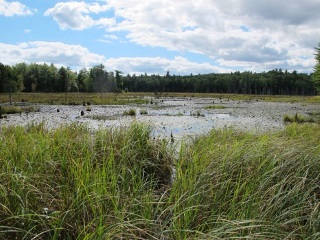 Emergent marsh and shrub swamp systems have a broad range of flood regimes, sometimes controlled by the presence or departure of beavers, but mostly controlled by groundwater. This system, which is an important food source for many species, is often grouped into three broad habitat categories: wet meadows, emergent marshes, and scrub-shrub wetlands. Marsh and shrub wetlands filter pollutants, preventing them from getting into local streams, and help hold water to reduce flooding. Many wildlife species use marsh and shrub wetlands including common species like red-winged blackbirds, beavers, and painted turtles. Marsh and shrub wetlands are also critically important for state endangered Blanding's turtles, New England cottontails, northern harriers, ringed boghaunters, and sedge wrens plus state threatened spotted turtles and pied billed grebes. Development is a threat to these habitats mostly from driveways and roads that fragment wetlands or change the flow of water. The loss of an upland habitat around a marsh or shrub wetland also increases the amount of pollution and sedimentation threatening the habitat. Another constant threat to marsh and shrub wetlands is invasive plants such as purple loosestrife and Japanese knotweed that compete with native vegetation. Some conservation strategies for marsh and shrub wetlands are restoration and protection of these important habitats. Many marsh and shrub wetlands are on private land and landowners can help restore and conserve them.
Emergent marsh and shrub swamp systems have a broad range of flood regimes, sometimes controlled by the presence or departure of beavers, but mostly controlled by groundwater. This system, which is an important food source for many species, is often grouped into three broad habitat categories: wet meadows, emergent marshes, and scrub-shrub wetlands. Marsh and shrub wetlands filter pollutants, preventing them from getting into local streams, and help hold water to reduce flooding. Many wildlife species use marsh and shrub wetlands including common species like red-winged blackbirds, beavers, and painted turtles. Marsh and shrub wetlands are also critically important for state endangered Blanding's turtles, New England cottontails, northern harriers, ringed boghaunters, and sedge wrens plus state threatened spotted turtles and pied billed grebes. Development is a threat to these habitats mostly from driveways and roads that fragment wetlands or change the flow of water. The loss of an upland habitat around a marsh or shrub wetland also increases the amount of pollution and sedimentation threatening the habitat. Another constant threat to marsh and shrub wetlands is invasive plants such as purple loosestrife and Japanese knotweed that compete with native vegetation. Some conservation strategies for marsh and shrub wetlands are restoration and protection of these important habitats. Many marsh and shrub wetlands are on private land and landowners can help restore and conserve them.
Species:
- American Black Duck
- American Woodcock
- Bald Eagle
- Bank Swallow
- Blanding's Turtle
- Blue-Spotted Salamander Complex
- Common Gallinule
- Eastern Box Turtle
- Eastern Hog-nosed Snake
- Eastern Ribbonsnake
- Fowler's Toad
- Jefferson Salamander Complex
- Kennedy's Emerald
- Least Bittern
- Lyre-tipped Spreadwing
- Marsh Wren
- Mink Frog
- Moose
- Northern Harrier
- Northern Leopard Frog
- Olive-Sided Flycatcher
- Pied-billed Grebe
- Ringed Boghaunter
- Ruffed Grouse
- Rusty Blackbird
- Sedge Wren
- Smooth Greensnake
- Sora
- Spotted Turtle
Northern Swamps
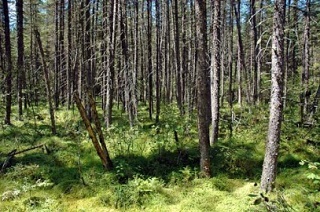 This habitat consists of forested wetlands found mainly in the northern half of the state, including black spruce peat swamps and forest seeps. Black spruce peat swamps are found in central and northern New Hampshire, typically in closed or stagnant basins with limited drainage. These swamps have a forest or woodland structure, but often surround open peatlands. Seeps occur where groundwater emerges at the soil surface and begins flowing into a stream. Despite their small size, they support a distinctive suite of plant species, and have value as wildlife habitat for some amphibians. Between 2004 and 2015, NH DES documented approximately 950 acres of wetlands lost in New Hampshire through development activities. Therefore, development of swamps, surrounding uplands, and impacts from fragmenting features like roads are all threats to this habitat. Other threats include increased temperatures that can cause changes in species composition, and eventual conversion to a different habitat type. The best action we can take to conserve swamps is to delineate forested swamps in northern New Hampshire, and add this information to the review process by the NH DES Wetlands Bureau.
This habitat consists of forested wetlands found mainly in the northern half of the state, including black spruce peat swamps and forest seeps. Black spruce peat swamps are found in central and northern New Hampshire, typically in closed or stagnant basins with limited drainage. These swamps have a forest or woodland structure, but often surround open peatlands. Seeps occur where groundwater emerges at the soil surface and begins flowing into a stream. Despite their small size, they support a distinctive suite of plant species, and have value as wildlife habitat for some amphibians. Between 2004 and 2015, NH DES documented approximately 950 acres of wetlands lost in New Hampshire through development activities. Therefore, development of swamps, surrounding uplands, and impacts from fragmenting features like roads are all threats to this habitat. Other threats include increased temperatures that can cause changes in species composition, and eventual conversion to a different habitat type. The best action we can take to conserve swamps is to delineate forested swamps in northern New Hampshire, and add this information to the review process by the NH DES Wetlands Bureau.
Species:
- American Water Shrew
- American Woodcock
- Big Brown Bat
- Blue-Spotted Salamander Complex
- Canada Warbler
- Cape May Warbler
- Eastern Red Bat
- Hoary Bat
- Jefferson Salamander Complex
- Kennedy's Emerald
- Little Brown Bat
- Lyre-tipped Spreadwing
- Mink Frog
- Moose
- Ocellated Emerald
- Olive-Sided Flycatcher
- Purple Finch
- Silver-Haired Bat
- Tricolored Bat
- Veery
Peatlands
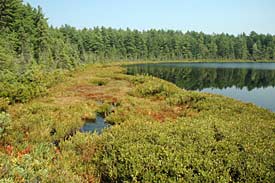 Peatland habitats are extremely important for carbon sequestration on a local and global scale. The water in peatlands has low nutrient content and typically high acidity caused by limited groundwater input and surface runoff. These environmental conditions are such that plant and animal material take a very long time to decompose. This organic material contains carbon and other nutrients, storing it away and slowly releasing it into the atmosphere. Drainage and destruction of peatlands releases this carbon into the atmosphere quicker, increasing greenhouse gases today. Conservation of the 11 different natural communities that comprise peatlands is also vital to the continued existence of many rare plant and wildlife species in New Hampshire. The state endangered ringed bog haunter uses peatlands and the surrounding uplands in the southern part of the state. The northern bog lemming inhabits burrows in the sphagnum moss and associated grasses. Typical vegetation in a peatland includes sphagnum moss, leather leaf, northern white cedar, and American larch. Threats to peatland habitats are development, altered hydrology (amount and flow of water), and unsustainable forest harvesting. Non-point source pollutants, such as road salt, lawn fertilizers, and pesticides, also threaten this habitat by altering the acidity and nutrients. Establishing buffers around this habitat is one conservation strategy that will help minimize the threats to peatland habitats.
Peatland habitats are extremely important for carbon sequestration on a local and global scale. The water in peatlands has low nutrient content and typically high acidity caused by limited groundwater input and surface runoff. These environmental conditions are such that plant and animal material take a very long time to decompose. This organic material contains carbon and other nutrients, storing it away and slowly releasing it into the atmosphere. Drainage and destruction of peatlands releases this carbon into the atmosphere quicker, increasing greenhouse gases today. Conservation of the 11 different natural communities that comprise peatlands is also vital to the continued existence of many rare plant and wildlife species in New Hampshire. The state endangered ringed bog haunter uses peatlands and the surrounding uplands in the southern part of the state. The northern bog lemming inhabits burrows in the sphagnum moss and associated grasses. Typical vegetation in a peatland includes sphagnum moss, leather leaf, northern white cedar, and American larch. Threats to peatland habitats are development, altered hydrology (amount and flow of water), and unsustainable forest harvesting. Non-point source pollutants, such as road salt, lawn fertilizers, and pesticides, also threaten this habitat by altering the acidity and nutrients. Establishing buffers around this habitat is one conservation strategy that will help minimize the threats to peatland habitats.
Species:
- Blanding's Turtle
- Blue-Spotted Salamander Complex
- Eastern Ribbonsnake
- Eastern Towhee
- Jefferson Salamander Complex
- Kennedy's Emerald
- Mink Frog
- Northern Harrier
- Ocellated Emerald
- Olive-Sided Flycatcher
- Pied-billed Grebe
- Pine Barrens Bluet
- Ringed Boghaunter
- Rusty Blackbird
- Sedge Darner
- Smooth Greensnake
- Spotted Turtle
Temperate Swamps
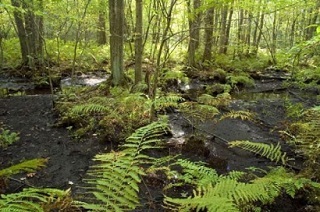 This habitat consists of forested wetlands found primarily in central and southern New Hampshire. Temperate peat swamps are typically found in isolated or stagnant basins with saturated, organic soils. The temperate swamps classification also includes the four known Atlantic white cedar communities in New Hampshire, and the pitch pine‐heath swamp, a rare community usually associated with the Pine Barrens landscape. Most coastal conifer peat swamps occur within 30 miles of the Atlantic coast. These wetlands provide a number of functions such as flood control, pollutant filters, shoreline stabilization, sediment retention and erosion control, food web productivity, wildlife habitat, recreation, and education. Threats to temperate swamps include habitat degradation from insect pests such as the hemlock woolly adelgid, since hemlock is a common component of temperate swamps across NH. Inputs of sedimentation, insecticides, and fertilizers are sources of pollution that threaten temperate swamp habitats. Actions to conserve temperate swamps include supporting the Division of Forests and Lands in the implementation of the hemlock woolly adelgid action plan, and working with foresters to use Best Management Practices outlined in the document ‘Good Forestry in the Granite State.’
This habitat consists of forested wetlands found primarily in central and southern New Hampshire. Temperate peat swamps are typically found in isolated or stagnant basins with saturated, organic soils. The temperate swamps classification also includes the four known Atlantic white cedar communities in New Hampshire, and the pitch pine‐heath swamp, a rare community usually associated with the Pine Barrens landscape. Most coastal conifer peat swamps occur within 30 miles of the Atlantic coast. These wetlands provide a number of functions such as flood control, pollutant filters, shoreline stabilization, sediment retention and erosion control, food web productivity, wildlife habitat, recreation, and education. Threats to temperate swamps include habitat degradation from insect pests such as the hemlock woolly adelgid, since hemlock is a common component of temperate swamps across NH. Inputs of sedimentation, insecticides, and fertilizers are sources of pollution that threaten temperate swamp habitats. Actions to conserve temperate swamps include supporting the Division of Forests and Lands in the implementation of the hemlock woolly adelgid action plan, and working with foresters to use Best Management Practices outlined in the document ‘Good Forestry in the Granite State.’
Species:
- American Woodcock
- Big Brown Bat
- Blanding's Turtle
- Blue-Spotted/Jefferson Salamander Complex
- Canada Warbler
- Coppery Emerald
- Eastern Box Turtle
- Eastern Red Bat
- Hoary Bat
- Jefferson Salamander Complex
- Kennedy's Emerald
- Little Brown Bat
- Moose
- Olive-Sided Flycatcher
- Ringed Boghaunter
- Silver-Haired Bat
- Spotted Turtle
- Tricolored Bat
- Veery
Vernal Pools
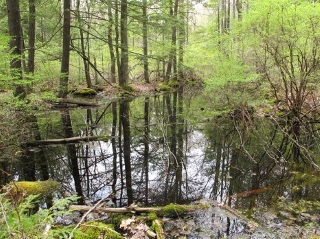 Vernal pools are wetland depressions characterized by small size, physical isolation from other wetlands, and periods of flooding and drying. Vernal pools can be found in almost every other habitat type and many wildlife species use them as a place to take a quick drink as they are passing through the area. Some species though are vernal pool-dependant and the loss of this habitat can result in local extinction of these species such as the fairy shrimp, wood frog, spotted salamander, blue-spotted salamander, Jefferson salamander, and the state endangered marbled salamander. The loss of vernal pool habitat due to development is therefore a huge threat, but the surrounding habitat is also just as important as the vernal pool itself.
Vernal pools are wetland depressions characterized by small size, physical isolation from other wetlands, and periods of flooding and drying. Vernal pools can be found in almost every other habitat type and many wildlife species use them as a place to take a quick drink as they are passing through the area. Some species though are vernal pool-dependant and the loss of this habitat can result in local extinction of these species such as the fairy shrimp, wood frog, spotted salamander, blue-spotted salamander, Jefferson salamander, and the state endangered marbled salamander. The loss of vernal pool habitat due to development is therefore a huge threat, but the surrounding habitat is also just as important as the vernal pool itself.
Most of the wildlife species that use vernal pools also spend a great deal of time in the surrounding habitat. Removing the tree canopy around a vernal pool also changes the amount of sunlight reaching the pool and can alter the temperature and the flooding and drying cycle. Some of the conservation strategies for vernal pools include habitat protection and supporting regulations that do not allow dredging and filling of vernal pools. Creating a model for vernal pools is very difficult because they can be found within so many other habitat types and because of the flooding and drying cycle it is not uncommon for vernal pools to be over looked during certain seasons or during drier years. Due to this challenge they were not mapped as part of the Wildlife Action Plan, but you can identify vernal pools on your property.
Learn More About Vernal Pool Documentation in NH
Species:
- Blanding's Turtle
- Blue-Spotted Salamander Complex
- Eastern Hog-nosed Snake
- Eastern Ribbonsnake
- Fowler's Toad
- Jefferson Salamander Complex
- Lyre-tipped Spreadwing
- Marbled Salamander
- Spotted Turtle
Coldwater Rivers and Streams
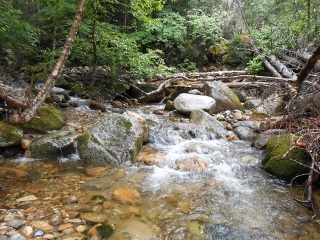 Coldwater rivers and streams are defined by their ability to maintain cold water temperatures during the hot summer months. The presence of coldwater fish species, including brook trout and slimy sculpin, is often an indicator of coldwater river or stream habitat. Brook trout are rarely found in rivers or streams that exceed a mean temperature of 20°C during the months of July and August. Coldwater rivers and streams are more common in northern New Hampshire and at higher elevations where a cooler local climate causes less warming throughout the summer. In southern New Hampshire and at lower elevations, the presence of coldwater streams depends primarily on the influence of groundwater. Riffles, pools, meander bends, and undercut banks are common habitat features within coldwater rivers and streams, and provide habitat for slimy sculpin, longnose sucker, and burbot. Cold water river and stream habitat is declining as average air temperatures increase with climate change. The increased frequency of intense rainfall events associated with climate change, in these often flashy systems, leads to habitat degradation associated with elevated levels of erosion and sedimentation, especially at the intersection of roads, bridges, and other infrastructure. Actions we can take to protect coldwater rivers and streams include improving habitat connectivity and reducing the impacts of dams on river and stream habitat, and reducing habitat degradation caused by stream crossings. We can preserve the water and habitat quality of rivers, streams and the shorelines of lakes and ponds by preventing development in the riparian zone.
Coldwater rivers and streams are defined by their ability to maintain cold water temperatures during the hot summer months. The presence of coldwater fish species, including brook trout and slimy sculpin, is often an indicator of coldwater river or stream habitat. Brook trout are rarely found in rivers or streams that exceed a mean temperature of 20°C during the months of July and August. Coldwater rivers and streams are more common in northern New Hampshire and at higher elevations where a cooler local climate causes less warming throughout the summer. In southern New Hampshire and at lower elevations, the presence of coldwater streams depends primarily on the influence of groundwater. Riffles, pools, meander bends, and undercut banks are common habitat features within coldwater rivers and streams, and provide habitat for slimy sculpin, longnose sucker, and burbot. Cold water river and stream habitat is declining as average air temperatures increase with climate change. The increased frequency of intense rainfall events associated with climate change, in these often flashy systems, leads to habitat degradation associated with elevated levels of erosion and sedimentation, especially at the intersection of roads, bridges, and other infrastructure. Actions we can take to protect coldwater rivers and streams include improving habitat connectivity and reducing the impacts of dams on river and stream habitat, and reducing habitat degradation caused by stream crossings. We can preserve the water and habitat quality of rivers, streams and the shorelines of lakes and ponds by preventing development in the riparian zone.
Species:
- American Brook Lamprey
- American Eel
- Appalachian Tiger Beetle
- Bald Eagle
- Bank Swallow
- Brook Trout
- Burbot
- Creeper
- Eastern Pearlshell
- Finescale Dace
- Northern Leopard Frog
- Northern Redbelly Dace
- Rainbow Smelt
- Round Whitefish
- Sea Lamprey
- Wood Turtle
Lakes and Ponds with Coldwater Habitat
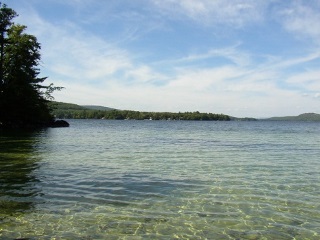 Lakes and ponds with coldwater habitat include lakes with deep, well oxygenated, cold water that support naturally reproducing populations of coldwater fish species (such as brook trout). This habitat also includes ponds at higher elevations (above 1,900 feet) which maintain cooler water temperatures despite their shallow depth. Although water quality in most lakes and ponds with coldwater habitat is relatively good, high levels of development along the shoreline and in the surrounding watersheds of some lakes may lead to issues, such as eutrophication, in the future. Habitat degradation from undersized stream crossings, pollution from run-off and untreated wastewater, and aquatic herbicide application are threats to this habitat. To conserve lakes and ponds with coldwater habitat, New Hampshire can work on reducing the aquatic habitat impacts associated with artificial water level fluctuation at dams, which can harm aquatic wildlife and plants. Other actions include further surveys to assess the distribution and status of high elevation coldwater pond habitat in New Hampshire, and map the distribution of coldwater fish spawning habitat in deep water lakes.
Lakes and ponds with coldwater habitat include lakes with deep, well oxygenated, cold water that support naturally reproducing populations of coldwater fish species (such as brook trout). This habitat also includes ponds at higher elevations (above 1,900 feet) which maintain cooler water temperatures despite their shallow depth. Although water quality in most lakes and ponds with coldwater habitat is relatively good, high levels of development along the shoreline and in the surrounding watersheds of some lakes may lead to issues, such as eutrophication, in the future. Habitat degradation from undersized stream crossings, pollution from run-off and untreated wastewater, and aquatic herbicide application are threats to this habitat. To conserve lakes and ponds with coldwater habitat, New Hampshire can work on reducing the aquatic habitat impacts associated with artificial water level fluctuation at dams, which can harm aquatic wildlife and plants. Other actions include further surveys to assess the distribution and status of high elevation coldwater pond habitat in New Hampshire, and map the distribution of coldwater fish spawning habitat in deep water lakes.
Species:
- American Eel
- Bank Swallow
- Brook Trout
- Burbot
- Common Loon
- Creeper
- Finescale Dace
- Lake Trout
- Lake Whitefish
- Mink Frog
- Northern Leopard Frog
- Northern Redbelly Dace
- Rainbow Smelt
- Ringed Emerald
- Round Whitefish
- Sedge Darner
Large Warm Water Rivers
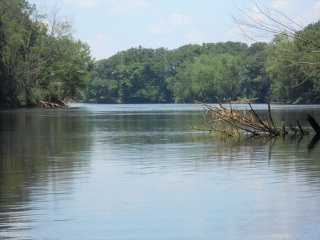 Large warm water rivers are defined as having watersheds greater than 1,000 square miles and an average bankfull width of over 250 feet. In New Hampshire, two rivers have been grouped into this category: the Merrimack River and the Connecticut River, downstream of the confluence with the Upper Ammonoosuc River. Large warm water rivers alternate between meandering river channels flowing through broad floodplain valleys and more confined sections flowing over boulders and rocky ledges. These rivers support a diverse array of both aquatic and terrestrial species. Large warm water rivers are important habitat for many diadromous fish species, which migrate in large numbers from the ocean to spawn or live in freshwater. Erosion, ice scour, sediment deposition, and periodic flooding caused by large warm water rivers create unique habitat features such as floodplain forests, sandy bluffs, and cobble bars. These habitats support a number of species of concern, including the bank swallow and the state-endangered cobblestone tiger beetle. Threats to this habitat type include habitat impacts from fragmentation due to impassable dams, and pollution from run-off, industrial sources, and untreated wastewater. We can help improve the conditions of large warm water rivers by restoring the natural habitat qualities of a river with practices such as wood additions, bank revegetation, floodplain restoration, or stream channel reconstruction. Another priority should be to construct, maintain, and monitor fishways at dams that currently limit access to suitable freshwater habitat for diadromous fish.
Large warm water rivers are defined as having watersheds greater than 1,000 square miles and an average bankfull width of over 250 feet. In New Hampshire, two rivers have been grouped into this category: the Merrimack River and the Connecticut River, downstream of the confluence with the Upper Ammonoosuc River. Large warm water rivers alternate between meandering river channels flowing through broad floodplain valleys and more confined sections flowing over boulders and rocky ledges. These rivers support a diverse array of both aquatic and terrestrial species. Large warm water rivers are important habitat for many diadromous fish species, which migrate in large numbers from the ocean to spawn or live in freshwater. Erosion, ice scour, sediment deposition, and periodic flooding caused by large warm water rivers create unique habitat features such as floodplain forests, sandy bluffs, and cobble bars. These habitats support a number of species of concern, including the bank swallow and the state-endangered cobblestone tiger beetle. Threats to this habitat type include habitat impacts from fragmentation due to impassable dams, and pollution from run-off, industrial sources, and untreated wastewater. We can help improve the conditions of large warm water rivers by restoring the natural habitat qualities of a river with practices such as wood additions, bank revegetation, floodplain restoration, or stream channel reconstruction. Another priority should be to construct, maintain, and monitor fishways at dams that currently limit access to suitable freshwater habitat for diadromous fish.
Species:
- Alewife
- Alewife Floater
- American Black Duck
- American Eel
- American Shad
- Atlantic Sturgeon
- Bald Eagle
- Bank Swallow
- Brook Floater
- Cobblestone Tiger Beetle
- Common Loon
- Creeper
- Dwarf Wedgemussel
- Fowler's Toad
- Northern Leopard Frog
- Puritan Tiger Beetle
- Rapids Clubtail
- Sea Lamprey
- Shortnose Sturgeon
- Skillet Clubtail
- Triangle Floater
Warm Water Lakes and Ponds
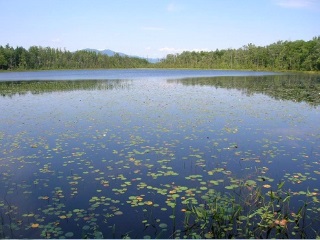 Warm water Lakes and Ponds are defined by their inability to support coldwater fish species due to a lack of cold, well oxygenated water in the summer. Instead, warm water lakes and ponds typically support warm water species such as large and smallmouth bass, bluegill, and chain pickerel. These habitats are widespread in New Hampshire and they vary in size, shape, and depth. Waterbodies representative of this category include Pawtuckaway Lake, Pemigewasset Lake, Baboosic Lake, and Country Pond, along with many others. Fishing and wildlife viewing in and around the lakes and ponds is an important contribution to the state's economy. Usually along the shoreline or in shallow areas of the lake, submerged aquatic vegetation provides critical spawning and nursery habitat for a number of fish species. Predators use aquatic vegetation as cover for ambushing prey. Turtles, amphibians, and fish feed on the abundant invertebrate species that are found among aquatic plants. In warm water lakes and ponds with undeveloped shorelines, waterfowl and many terrestrial species will use the lake or pond as nesting or foraging habitat. One potential threat to this habitat is lake drawdowns and water level management, which can reduce shoreline plant communities and expose aquatic organisms to desiccation during the winter. Pollution from industrial sources, run-off, and untreated wastewater are other major threats to lake and pond ecosystems. Conservation actions for this habitat include protecting important habitat features along shorelines with vegetated buffers;, and working with dam managers to avoid rapid changes in water level, excessive winter drawdown, and reductions in downstream flow.
Warm water Lakes and Ponds are defined by their inability to support coldwater fish species due to a lack of cold, well oxygenated water in the summer. Instead, warm water lakes and ponds typically support warm water species such as large and smallmouth bass, bluegill, and chain pickerel. These habitats are widespread in New Hampshire and they vary in size, shape, and depth. Waterbodies representative of this category include Pawtuckaway Lake, Pemigewasset Lake, Baboosic Lake, and Country Pond, along with many others. Fishing and wildlife viewing in and around the lakes and ponds is an important contribution to the state's economy. Usually along the shoreline or in shallow areas of the lake, submerged aquatic vegetation provides critical spawning and nursery habitat for a number of fish species. Predators use aquatic vegetation as cover for ambushing prey. Turtles, amphibians, and fish feed on the abundant invertebrate species that are found among aquatic plants. In warm water lakes and ponds with undeveloped shorelines, waterfowl and many terrestrial species will use the lake or pond as nesting or foraging habitat. One potential threat to this habitat is lake drawdowns and water level management, which can reduce shoreline plant communities and expose aquatic organisms to desiccation during the winter. Pollution from industrial sources, run-off, and untreated wastewater are other major threats to lake and pond ecosystems. Conservation actions for this habitat include protecting important habitat features along shorelines with vegetated buffers;, and working with dam managers to avoid rapid changes in water level, excessive winter drawdown, and reductions in downstream flow.
Species:
- Alewife
- Alewife Floater
- American Eel
- American Black Duck
- Bald Eagle
- Banded Sunfish
- Blueback Herring
- Bridle Shiner
- Common Loon
- Creeper
- Eastern Pondmussel
- Finescale Dace
- Fowler's Toad
- Moose
- Redfin Pickerel
- Swamp Darter
- Triangle Floater
Warm Water Rivers and Streams
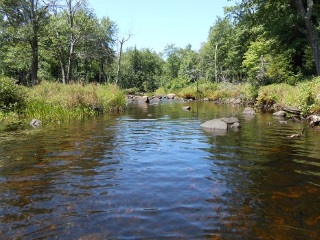 Warm water rivers and streams have an average water temperature above 20°C during the months of July and August, which is above the temperature tolerance of brook trout, a coldwater fish species. Warm water rivers and streams are more common in southern New Hampshire, but they may be found anywhere in the state. Low gradient, slow flowing warm water rivers and streams often contain submerged aquatic vegetation and share similarities with the shoreline habitat of warm water lakes and ponds. Faster flowing warm water rivers and streams may have the appearance of a coldwater stream, but they are home to a different community of fish species, including fallfish, longnose dace, and creek chubs. These habitats are critical for a number of species of conservation concern, including the state-threatened bridle shiner, the banded sunfish, and the state-endangered brook floater mussel. Habitat degradation from stormwater run‐off from impervious surfaces and poorly sized stream crossings are major threats to warm water rivers and streams. The use of large scale aquatic herbicide applications (usually used to treat invasive plants) was also identified as an emerging threat, since it removes all submerged aquatic vegetation, which is critical habitat to many aquatic species. To conserve these habitats, actions to take include increasing connectivity and reducing habitat degradation caused by stream crossings and dams that block fish passage; and preventing development in the riparian zone.
Warm water rivers and streams have an average water temperature above 20°C during the months of July and August, which is above the temperature tolerance of brook trout, a coldwater fish species. Warm water rivers and streams are more common in southern New Hampshire, but they may be found anywhere in the state. Low gradient, slow flowing warm water rivers and streams often contain submerged aquatic vegetation and share similarities with the shoreline habitat of warm water lakes and ponds. Faster flowing warm water rivers and streams may have the appearance of a coldwater stream, but they are home to a different community of fish species, including fallfish, longnose dace, and creek chubs. These habitats are critical for a number of species of conservation concern, including the state-threatened bridle shiner, the banded sunfish, and the state-endangered brook floater mussel. Habitat degradation from stormwater run‐off from impervious surfaces and poorly sized stream crossings are major threats to warm water rivers and streams. The use of large scale aquatic herbicide applications (usually used to treat invasive plants) was also identified as an emerging threat, since it removes all submerged aquatic vegetation, which is critical habitat to many aquatic species. To conserve these habitats, actions to take include increasing connectivity and reducing habitat degradation caused by stream crossings and dams that block fish passage; and preventing development in the riparian zone.
Species:
- Alewife
- Alewife Floater
- American Black Duck
- American Brook Lamprey
- American Eel
- Appalachian Tiger Beetle
- Bald Eagle
- Banded Sunfish
- Bank Swallow
- Blueback Herring
- Bridal Shiner
- Brook Floater
- Common Loon
- Creeper
- Dwarf Wedgemussel
- Eastern Pondmussel
- Fowler's Toad
- Northern Leopard Frog
- Rainbow Smelt
- Rapids Clubtail
- Redfin Pickerel
- Sea Lamprey
- Skillet Clubtail
- Swamp Darter
- Triangle Floater
- Wood Turtle
Coastal Islands and Rocky Shores
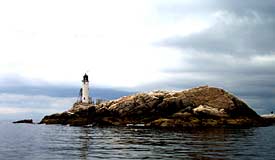 Coastal islands have rocky shores, and are usually remote, undisturbed, and free of predators. As well as providing critical wildlife habitat, these islands are host evidence of New Hampshire's rich and vibrant maritime past. Vegetation on these islands typically includes grasses, herbaceous plants, and shrub thickets growing among rocky outcrops, with few to no trees. New Hampshire's Isles of Shoals serve as an important site for neotropical bird migration and provide wintering habitat for land birds. Seavey and White Islands provide breeding grounds for federally endangered roseate terns, state endangered least terns, and state threatened common terns. In addition to birds, other wildlife species use these islands such as seals, barnacles, and monarchs. The most challenging issues facing coastal island habitat and seabird communities are over-populated introduced predators such as gulls. Other threats include recreation and climate change. Habitat protection, controlling overpopulated predators, and preparing for oil spills are a few of the conservation strategies for coastal islands.
Coastal islands have rocky shores, and are usually remote, undisturbed, and free of predators. As well as providing critical wildlife habitat, these islands are host evidence of New Hampshire's rich and vibrant maritime past. Vegetation on these islands typically includes grasses, herbaceous plants, and shrub thickets growing among rocky outcrops, with few to no trees. New Hampshire's Isles of Shoals serve as an important site for neotropical bird migration and provide wintering habitat for land birds. Seavey and White Islands provide breeding grounds for federally endangered roseate terns, state endangered least terns, and state threatened common terns. In addition to birds, other wildlife species use these islands such as seals, barnacles, and monarchs. The most challenging issues facing coastal island habitat and seabird communities are over-populated introduced predators such as gulls. Other threats include recreation and climate change. Habitat protection, controlling overpopulated predators, and preparing for oil spills are a few of the conservation strategies for coastal islands.
Species:
- Common Tern
- Purple Sandpiper
- Red Knot
- Roseate Tern
- Ruddy Turnstone
- Sanderling
- Semipalmated Sandpiper
- Whimbrel
Dunes
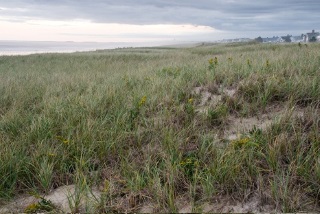 Coastal sand dunes are constantly changing areas of sand and gravel that are deposited by wave and wind action within a marine beach system. This habitat is important to residential and commercial buildings along the coast because it provides some shelter from storms, wind, waves, erosion, and rising seal levels. Coastal dunes are considered one of New Hampshire's most at-risk habitats and are used by many birds for breeding, migration, or wintering. The federally threatened and state endangered piping plover uses this habitat for breeding and the semi-palmated sandpiper and horned lark are two of the many bird species that use dune habitat during migration. New Hampshire has less than 19 miles of Atlantic coastline, of which less than 2 miles are dune habitat (the rest being rocky shoreline). Development has reduced the places where dunes would naturally shift, forcing this habitat to be more static or to shift into recreational areas. Other threats to this habitat are oil spills and rising sea level resulting from climate change. As beach goers this summer we can all help by staying off dune habitats and obeying restricted area signs and fences. Habitat protection, education, and enforcing laws and regulations are a few of the conservation strategies for dunes.
Coastal sand dunes are constantly changing areas of sand and gravel that are deposited by wave and wind action within a marine beach system. This habitat is important to residential and commercial buildings along the coast because it provides some shelter from storms, wind, waves, erosion, and rising seal levels. Coastal dunes are considered one of New Hampshire's most at-risk habitats and are used by many birds for breeding, migration, or wintering. The federally threatened and state endangered piping plover uses this habitat for breeding and the semi-palmated sandpiper and horned lark are two of the many bird species that use dune habitat during migration. New Hampshire has less than 19 miles of Atlantic coastline, of which less than 2 miles are dune habitat (the rest being rocky shoreline). Development has reduced the places where dunes would naturally shift, forcing this habitat to be more static or to shift into recreational areas. Other threats to this habitat are oil spills and rising sea level resulting from climate change. As beach goers this summer we can all help by staying off dune habitats and obeying restricted area signs and fences. Habitat protection, education, and enforcing laws and regulations are a few of the conservation strategies for dunes.
Species:
- American Pipit
- Fowler's Toad
- Horned Lark
- Least Tern
- Piping Plover
- Red Knot
- Ruddy Turnstone
- Saltmarsh Tiger Beetle
- Sanderling
- Semipalmated Sandpiper
- Whimbrel
- Willet
Estuarine
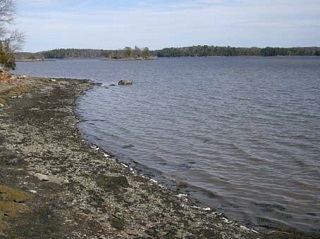 Estuarine habitats form where rivers meet the sea, in the Great Bay and Coastal watersheds. This includes eelgrass beds, oyster reefs, and intertidal mudflats. Rivers carry nutrients, organic matter, and sediments to estuaries. All of these inputs combine to make estuaries extremely productive habitats with a great abundance of plants and animals. Both the Hampton‐Seabrook and Great Bay estuaries have been designated an Important Bird Area. Species that use estuarine waters for spawning and nursery habitat include smelt, American shad, blueback herring, and horseshoe crabs. The shallow waters of estuaries provide feeding opportunities for osprey and waterfowl. Threats to estuaries include oil spills, problems with excess nitrogen and associated algal blooms, and diseases that impact both the wildlife species and plant communities of estuaries. Actions we can take to conserve estuary habitat include supporting a multi-agency oil spill response plan, and reducing the amount of nitrogen entering estuarine habitat by improving vegetated buffers and upgrading maintenance of septic systems and treatment plants.
Estuarine habitats form where rivers meet the sea, in the Great Bay and Coastal watersheds. This includes eelgrass beds, oyster reefs, and intertidal mudflats. Rivers carry nutrients, organic matter, and sediments to estuaries. All of these inputs combine to make estuaries extremely productive habitats with a great abundance of plants and animals. Both the Hampton‐Seabrook and Great Bay estuaries have been designated an Important Bird Area. Species that use estuarine waters for spawning and nursery habitat include smelt, American shad, blueback herring, and horseshoe crabs. The shallow waters of estuaries provide feeding opportunities for osprey and waterfowl. Threats to estuaries include oil spills, problems with excess nitrogen and associated algal blooms, and diseases that impact both the wildlife species and plant communities of estuaries. Actions we can take to conserve estuary habitat include supporting a multi-agency oil spill response plan, and reducing the amount of nitrogen entering estuarine habitat by improving vegetated buffers and upgrading maintenance of septic systems and treatment plants.
Species:
- American Black Duck
- American Oyster
- American Shad
- Atlantic Sturgeon
- Blueback Herring
- Rainbow Smelt
- Red Knot
- Ruddy Turnstone
- Sanderling
- Sea Lamprey
- Semipalmated Sandpiper
- Shortnose Sturgeon
- Whimbrel
- Willet
Marine
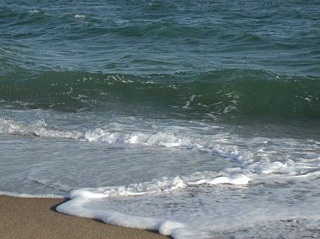 Marine habitats are purely aquatic, in contrast to other coastal habitats such as salt marshes, rocky shores, or dunes. Marine habitat can be generalized to refer to offshore waters including both pelagic and benthic zones as well as the surface of the waters where organisms such as waterfowl may be found. Although State jurisdiction only extends three miles offshore, this delineation has no ecological basis, and marine systems shared by neighboring states are considered in their entirety for the purposes of this habitat category. Coastal migratory fish such as striped bass, mackerel and bluefish frequent nearshore waters. Other important commercially and recreationally harvested species include Atlantic cod, haddock, Pollock and lobsters. Seals and harbor porpoises are common mammals associated with nearshore marine systems in NH. Threats to this habitat include impacts from increasing sea surface temperatures that cause stress for marine life and alterations of marine currents, ocean acidification, and oil spills. Actions to conserve marine habitats include further research into potential shifts in marine food webs in response to ocean acidification, conduct surveys in order to maintain sustainable harvest limits of marine species, and support national standards to reduce mercury and other air pollutants from power plants.
Marine habitats are purely aquatic, in contrast to other coastal habitats such as salt marshes, rocky shores, or dunes. Marine habitat can be generalized to refer to offshore waters including both pelagic and benthic zones as well as the surface of the waters where organisms such as waterfowl may be found. Although State jurisdiction only extends three miles offshore, this delineation has no ecological basis, and marine systems shared by neighboring states are considered in their entirety for the purposes of this habitat category. Coastal migratory fish such as striped bass, mackerel and bluefish frequent nearshore waters. Other important commercially and recreationally harvested species include Atlantic cod, haddock, Pollock and lobsters. Seals and harbor porpoises are common mammals associated with nearshore marine systems in NH. Threats to this habitat include impacts from increasing sea surface temperatures that cause stress for marine life and alterations of marine currents, ocean acidification, and oil spills. Actions to conserve marine habitats include further research into potential shifts in marine food webs in response to ocean acidification, conduct surveys in order to maintain sustainable harvest limits of marine species, and support national standards to reduce mercury and other air pollutants from power plants.
Species:
- American Shad
- Atlantic Sea Scallop
- Atlantic Sturgeon
- Blueback Herring
- Fin Whale
- Horseshoe Crab
- Humpback Whale
- North Atlantic Right Whale
- Northern Shrimp
- Rainbow Smelt
- Sea Lamprey
- Shortnose Sturgeon
- Softshell Clam
Salt Marsh
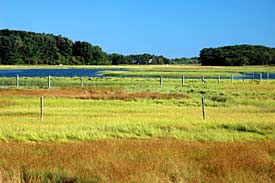 Salt marshes are grass-dominated tidal wetlands existing in the transition zone between ocean and upland. They are among the most productive ecosystems in the world and provide great habitat for many bird species including American bittern, Nelson's sharp-tailed sparrow, salt marsh sharp-tailed sparrow, seaside sparrow, and semipalmated sandpiper. Salt marsh plants are salt-tolerant and adapted to fluctuating water levels. Nutrients that stimulate marsh plant growth are carried in with the tides, and organic matter that feeds fish and other organisms is carried out by the tides. Over time, organic matter accumulates on the marsh and forms peat. By building up more peat, salt marsh elevation can keep apace with rising sea level, unless the rate of sea-level rise becomes too great, such as is predicted from climate change. Salt marshes help protect coastal areas from storm surges, but an estimated 30-50% of New Hampshire's original salt marsh habitat has been lost to development. Some of the conservation strategies for salt marshes are restoring and protecting the remaining salt marsh habitat and surrounding upland buffer habitat.
Salt marshes are grass-dominated tidal wetlands existing in the transition zone between ocean and upland. They are among the most productive ecosystems in the world and provide great habitat for many bird species including American bittern, Nelson's sharp-tailed sparrow, salt marsh sharp-tailed sparrow, seaside sparrow, and semipalmated sandpiper. Salt marsh plants are salt-tolerant and adapted to fluctuating water levels. Nutrients that stimulate marsh plant growth are carried in with the tides, and organic matter that feeds fish and other organisms is carried out by the tides. Over time, organic matter accumulates on the marsh and forms peat. By building up more peat, salt marsh elevation can keep apace with rising sea level, unless the rate of sea-level rise becomes too great, such as is predicted from climate change. Salt marshes help protect coastal areas from storm surges, but an estimated 30-50% of New Hampshire's original salt marsh habitat has been lost to development. Some of the conservation strategies for salt marshes are restoring and protecting the remaining salt marsh habitat and surrounding upland buffer habitat.
Species:
- Common Tern
- Marsh Wren
- Nelson's Sparrow
- Northern Harrier
- Purple Martin
- Red Knot
- Roseate Tern
- Saltmarsh Sparrow
- Saltmarsh Tiger Beetle
- Sanderling
- Seaside Sparrow
- Semipalmated Sandpiper
- Whimbrel
- Willet



